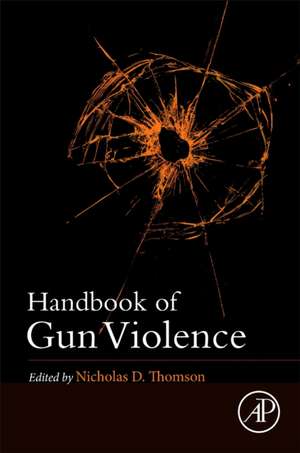Handbook of Gun Violence
Editat de Nicholas D Thomsonen Limba Engleză Paperback – 29 oct 2024
- Provides an extensive review of gun violence statistics and trends.
- Examines the biopsychosocial risk and protective factors for violence in youth and adults
- Reviews evidence-based intervention and prevention programs for gun violence
- Assesses global policies for gun violence prevention and discusses the impact of funding and research on violence prevention.
Preț: 830.64 lei
Preț vechi: 1012.98 lei
-18% Nou
Puncte Express: 1246
Preț estimativ în valută:
158.99€ • 167.04$ • 133.62£
158.99€ • 167.04$ • 133.62£
Carte indisponibilă temporar
Doresc să fiu notificat când acest titlu va fi disponibil:
Se trimite...
Preluare comenzi: 021 569.72.76
Specificații
ISBN-13: 9780323952729
ISBN-10: 0323952720
Pagini: 606
Dimensiuni: 216 x 276 mm
Greutate: 0.45 kg
Editura: ELSEVIER SCIENCE
ISBN-10: 0323952720
Pagini: 606
Dimensiuni: 216 x 276 mm
Greutate: 0.45 kg
Editura: ELSEVIER SCIENCE
Cuprins
Foreword Section A: Epidemiology/Public health 1. The History of Firearm Injury Prevention Research 2. The Public Health Approach for Firearm Violence and Injury Prevention 3. IPV and Gun Violence: A Focus on Teen Dating Violence 4. Firearm Suicide Risk and Prevention Among Service Members 5. Firearm Suicide 6. Inequities in Interpersonal Firearm Violence 7. The Epidemiology and Prevention of Unintentional Firearm Injuries Section B: Biopsychosocial 8. Risk and Protective Factors for Adolescent Gun Carrying and Firearm Violence 9. Neurobiology of Violence 10. Guns, Genes, and Crime 11. Psychopathy and Violence 12. Contagious Effects of Gun Violence in the Media: A Social-Cognitive Perspective 13. A Social-Ecological Model to Understand Gun Violence Section C: Violence Prevention and Intervention 14. Healthcare-Based Firearm Injury Prevention 15. Firearm Suicide Prevention 16. Technical Assistance as a Tool to Enhance the Dissemination and Implementation of Firearm Violence Prevention and Intervention Strategies 17. Community-Based Approaches to Prevent Firearm Violence 18. Place-based approaches to Firearm Violence Prevention 19. Psychosocial Interventions for Children and Adolescents with Conduct Problems 20. Prison-Based Interventions for Violence 21. Gun Violence and Its Influence on School Safety and Security 22. Hunting Safety 23. Enhancing the Translation of Violence Prevention Efforts and Research in Politically Charged Policy Environments Section D: Forensic Psychology 24. Firearm Violence and Individuals with Serious Mental Illnesses 25. Offender Profiling and Gun Crime 26. Mass Shootings 27. Terrorism and Gun Violence 28. Violence Risk Assessment and Management Section E: Criminology 29. The Gun-Centric Nature of Gang Violence 30. Forced Migration and Gun Violence: What do we Know? 31. Firearms Trafficking and Transnational Crime 32. A Neurocriminological Perspective on Violence Section F: Funding, Surveillance Data, and Research Methods 33. Emerging Research Areas and Contributions of NIH in Firearm Injury and Mortality Research 34. Federal and Foundation Funding for Gun Violence Prevention Programming and Research 35. Public Health Surveillance of Nonfatal Firearm Injuries 36. Public Health Surveillance of Firearm Injury Deaths 37. Applying Data Science to the Study of Gun Violence 38. Research methods: Considerations and Opportunities to Advance Firearm Injury and Violence Prevention Section G: Policy and Politics 39. New Zealand Experience with Gun Violence and Gun Control 40. European Experience with Gun Violence and Gun Control 41. U.S. Experience with Gun Violence and Gun Control
Recenzii
Quote from Published Foreword: “In summary, the Handbook of Gun Violence is much more than a compilation of research findings and theoretical insights; it serves as a light guiding the path toward understanding, preventing, and ultimately reducing gun violence. Through these pages, the reader is exposed to a multifaceted landscape of gun violence, equipped with a deeper comprehension of its root causes, affected populations, and the pervasive impact on societies worldwide. This handbook marks a pivotal step in rallying researchers, practitioners, policymakers, and communities to join forces in a multidisciplinary effort to address gun violence. By casting a wide net over the complexities of this issue, it challenges the status quo, provides innovative approaches, and forges new pathways that lead to safer and more resilient communities. Through collaborative exploration, rigorous research, and unwavering dedication to public health and safety, the Handbook of Gun Violence aspires to turn the tide against gun violence, crafting a legacy of peace and security for future generations. I am glad to have it as a resource on my bookshelf.” -- Brad J. Bushman, Ph.D. Editor, Psychology of Violence, Executive Secretary, International Society for Research on Aggression, Professor, School of Communication, The Ohio State University
"The public health crisis of firearm injuries has received too little scholarly attention for too long. The Handbook of Gun Violence shines a light on this critical issue and explores the most promising solutions. This comprehensive volume is sure to become a go-to reference in our field." -- Jonathan Jay, DrPH JD, Assistant Professor, Boston University School of Public Health
"The public health crisis of firearm injuries has received too little scholarly attention for too long. The Handbook of Gun Violence shines a light on this critical issue and explores the most promising solutions. This comprehensive volume is sure to become a go-to reference in our field." -- Jonathan Jay, DrPH JD, Assistant Professor, Boston University School of Public Health
